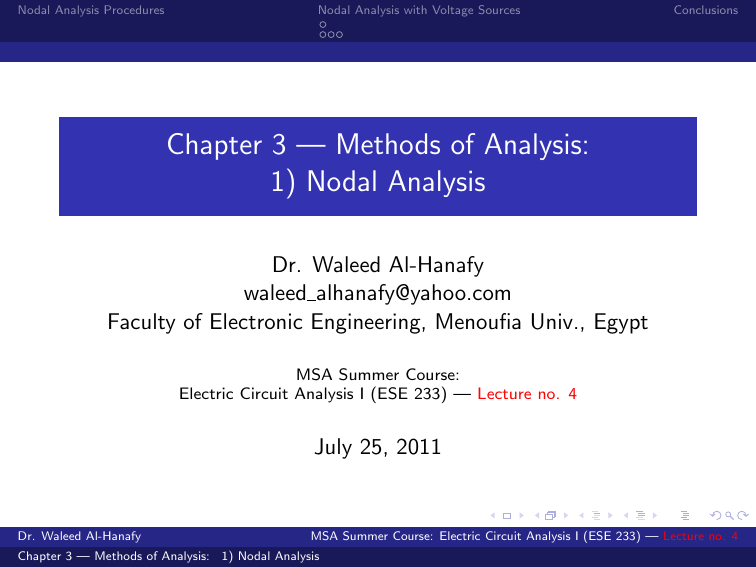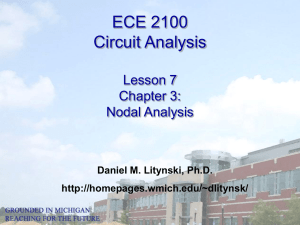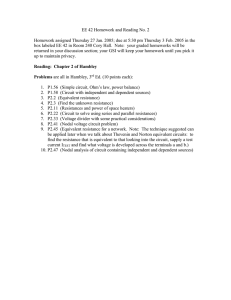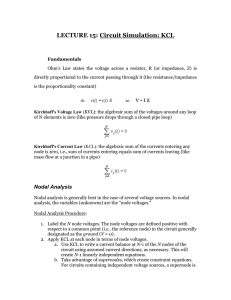Chapter 3 — Methods of Analysis: 1) Nodal Analysis
advertisement

Nodal Analysis Procedures Nodal Analysis with Voltage Sources Conclusions Chapter 3 — Methods of Analysis: 1) Nodal Analysis Dr. Waleed Al-Hanafy waleed alhanafy@yahoo.com Faculty of Electronic Engineering, Menoufia Univ., Egypt MSA Summer Course: Electric Circuit Analysis I (ESE 233) — Lecture no. 4 July 25, 2011 Dr. Waleed Al-Hanafy MSA Summer Course: Electric Circuit Analysis I (ESE 233) — Lecture no. 4 Chapter 3 — Methods of Analysis: 1) Nodal Analysis Nodal Analysis Procedures Nodal Analysis with Voltage Sources Conclusions Overview 1 Nodal Analysis Procedures 2 Nodal Analysis with Voltage Sources Case 1 Case 2 3 Conclusions Reference: [1] Alexander Sadiku, Fundamentals of Electric Circuits, 4th ed. McGraw-Hill, 2009. Dr. Waleed Al-Hanafy MSA Summer Course: Electric Circuit Analysis I (ESE 233) — Lecture no. 4 Chapter 3 — Methods of Analysis: 1) Nodal Analysis Nodal Analysis Procedures Nodal Analysis with Voltage Sources Conclusions Introduction Having understood the fundamental laws of circuit theory (Ohm’s law and Kirchhoff’s laws), we are now prepared to apply these laws to develop two powerful techniques for circuit analysis: nodal analysis, which is based on a systematic application of Kirchhoff’s current law (KCL), and mesh analysis, which is based on a systematic application of Kirchhoff’s voltage law (KVL). With the two techniques to be developed we can analyse almost any circuit by obtaining a set of simultaneous equations that are then solved to obtain the required values of current or voltage. Nodal analysis provides a general procedure for analysing circuits using node voltages as the circuit variables. In nodal analysis, we are interested in finding the node voltages. Dr. Waleed Al-Hanafy MSA Summer Course: Electric Circuit Analysis I (ESE 233) — Lecture no. 4 Chapter 3 — Methods of Analysis: 1) Nodal Analysis Nodal Analysis Procedures Nodal Analysis with Voltage Sources Conclusions Nodal Method Steps Steps to Determine the Node Voltages: 1 Select a node as the reference node. Assign voltages v1 , v2 ,· · · , vn−1 to the remaining n − 1 nodes. The voltages are referenced with respect to the reference node 2 Apply KCL to each of the n − 1 nonreference nodes. Use Ohm’s law to express the branch currents in terms of node voltages 3 Solve the resulting simultaneous equations to obtain the unknown node voltages Dr. Waleed Al-Hanafy MSA Summer Course: Electric Circuit Analysis I (ESE 233) — Lecture no. 4 Chapter 3 — Methods of Analysis: 1) Nodal Analysis Nodal Analysis Procedures Nodal Analysis with Voltage Sources Conclusions Example-1 Calculate the node voltages in the circuit shown At node 1, applying KCL and Ohm’s law gives i1 = i2 + i3 v1 − v2 v1 − 0 + 4 2 =⇒ 3v1 − v2 = 20 or 5 = At node 2, we do the same thing and get i2 + i4 = i1 + i5 or Dr. Waleed Al-Hanafy v2 − 0 v1 − v2 + 10 = 5 + 4 6 =⇒ −3v1 + 5v2 = 60 MSA Summer Course: Electric Circuit Analysis I (ESE 233) — Lecture no. 4 Chapter 3 — Methods of Analysis: 1) Nodal Analysis Nodal Analysis Procedures Nodal Analysis with Voltage Sources Conclusions Example-1 (cont’d) Solving both equations using either 1) elimination technique, or 2) Cramer’s rule We can get v1 = 13.33 V and v2 = 20 V Cramer’s rule: 3 −3 −1 5 ∆1 = Thus v1 = ∆1 ∆ v1 v2 20 60 = −1 5 20 60 , = 160, = 13.33 V and v2 = ∆2 ∆ ∆= ∆2 = 3 −3 3 −3 −1 5 20 60 = 15 − 3 = 12, = 240, = 20 V, you can use these results to obtain i2 , i3 , and i5 Dr. Waleed Al-Hanafy MSA Summer Course: Electric Circuit Analysis I (ESE 233) — Lecture no. 4 Chapter 3 — Methods of Analysis: 1) Nodal Analysis Nodal Analysis Procedures Nodal Analysis with Voltage Sources Conclusions Exercise-1 Obtain the node voltages in the circuit in shown Answer: v1 = −2 V, v2 = −14 V Dr. Waleed Al-Hanafy MSA Summer Course: Electric Circuit Analysis I (ESE 233) — Lecture no. 4 Chapter 3 — Methods of Analysis: 1) Nodal Analysis Nodal Analysis Procedures Nodal Analysis with Voltage Sources Conclusions Example-2 Determine the voltages at the nodes shown At node1 3 = i1 + ix ⇒ 3 = v1 − v3 v1 − v2 + 4 2 =⇒ 3v1 − 2v2 − v3 = 12 At node2 ix = i2 + i3 ⇒ v1 − v2 v2 − v3 v2 − 0 = + 2 8 4 =⇒ −4v1 + 7v2 − v3 = 0 At node3 i1 + i2 = 2ix ⇒ v1 − v3 v2 − v3 2(v1 − v2 ) + = 4 8 2 =⇒ 2v1 − 3v2 + v3 = 0 → v1 = 4.8, v2 = 2.4, v3 = −2.4 Dr. Waleed Al-Hanafy MSA Summer Course: Electric Circuit Analysis I (ESE 233) — Lecture no. 4 Chapter 3 — Methods of Analysis: 1) Nodal Analysis Nodal Analysis Procedures Nodal Analysis with Voltage Sources Conclusions Supernode A supernode is formed by enclosing a (dependent or independent) voltage source connected between two nonreference nodes and any elements connected in parallel with it. v1 = 10 V i1 + i4 = i2 + i3 −v2 + 5 + v3 = 0 Dr. Waleed Al-Hanafy MSA Summer Course: Electric Circuit Analysis I (ESE 233) — Lecture no. 4 Chapter 3 — Methods of Analysis: 1) Nodal Analysis Nodal Analysis Procedures Nodal Analysis with Voltage Sources Conclusions Case 1 Case 1 If a voltage source is connected between the reference node and a nonreference node, we simply set the voltage at the nonreference node equal to the voltage of the voltage source. Dr. Waleed Al-Hanafy MSA Summer Course: Electric Circuit Analysis I (ESE 233) — Lecture no. 4 Chapter 3 — Methods of Analysis: 1) Nodal Analysis Nodal Analysis Procedures Nodal Analysis with Voltage Sources Conclusions Case 2 Case 2 If the voltage source (dependent or independent) is connected between two nonreference nodes, the two nonreference nodes form a generalised node or supernode; we apply both KCL and KVL to determine the node voltages. Dr. Waleed Al-Hanafy MSA Summer Course: Electric Circuit Analysis I (ESE 233) — Lecture no. 4 Chapter 3 — Methods of Analysis: 1) Nodal Analysis Nodal Analysis Procedures Nodal Analysis with Voltage Sources Conclusions Case 2 Example-3 For the circuit shown find the node voltages At supernode 2 = i1 + i2 + 7 ⇒ 2 = v1 − 0 v2 − 0 + +7 2 4 =⇒ v2 = −20 − 2v1 Apply KVL − v1 − 2 + v2 = 0 Thus v1 = −7.333 V and v2 = −5.333 V Dr. Waleed Al-Hanafy MSA Summer Course: Electric Circuit Analysis I (ESE 233) — Lecture no. 4 Chapter 3 — Methods of Analysis: 1) Nodal Analysis Nodal Analysis Procedures Nodal Analysis with Voltage Sources Conclusions Case 2 Homework Find v and i in the circuit shown using the nodal analysis method Answer: -0.2 V, 1.4 A Dr. Waleed Al-Hanafy MSA Summer Course: Electric Circuit Analysis I (ESE 233) — Lecture no. 4 Chapter 3 — Methods of Analysis: 1) Nodal Analysis Nodal Analysis Procedures Nodal Analysis with Voltage Sources Conclusions Conclusion Concluding remarks Nodal analysis method is studied as a key tool to analyse any circuit Basic nodal analysis steps is introduced highlighted by some examples The case of supernode is also given with examples Next — another analysis method known as mesh analysis will be introduced . Dr. Waleed Al-Hanafy MSA Summer Course: Electric Circuit Analysis I (ESE 233) — Lecture no. 4 Chapter 3 — Methods of Analysis: 1) Nodal Analysis





